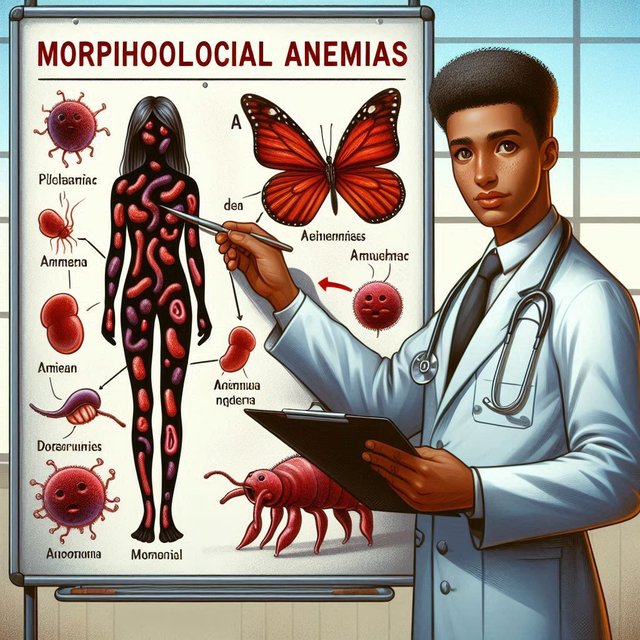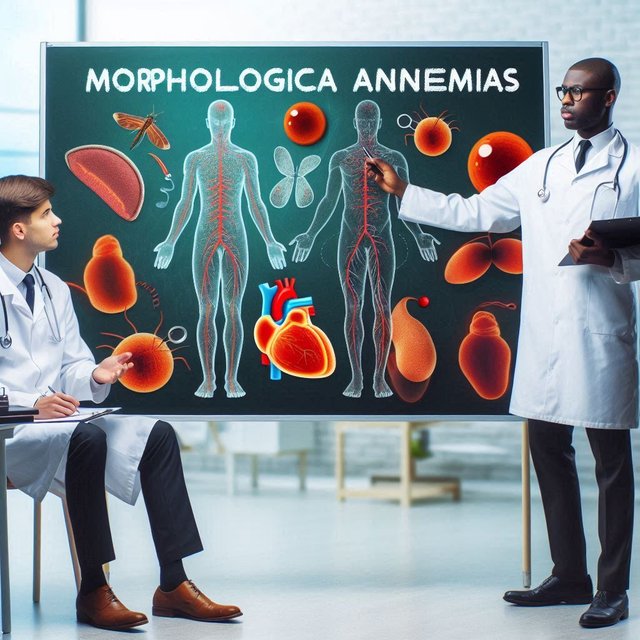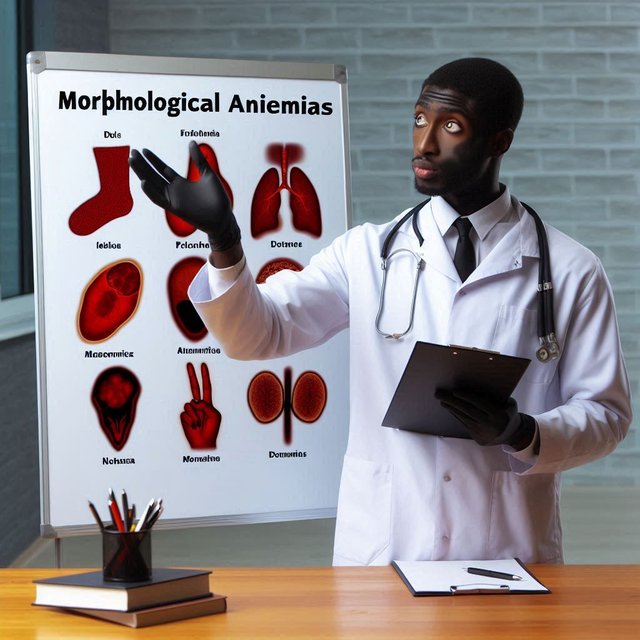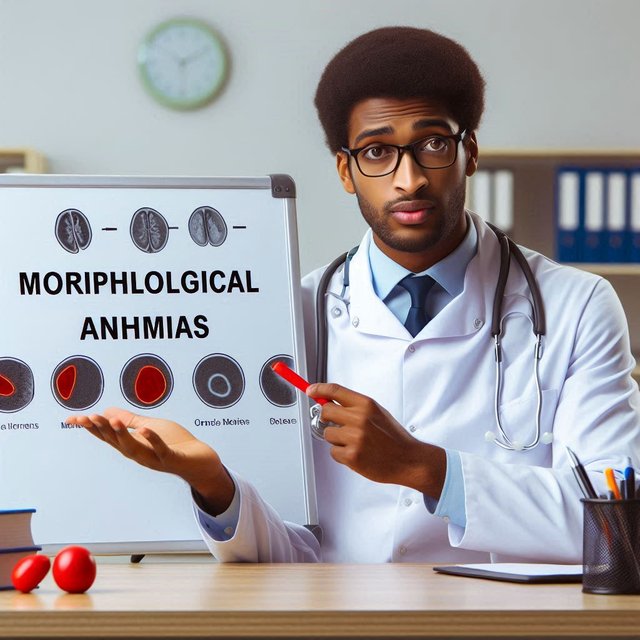Greetings everyone, it is a pleasure to join this week's engagement challenge which was organized by @dexsyluz who happens to be one of the members of the Teaching teams for season 20. Today I'm participating in the contest titled Morphological Anemias - Module 3. A few questions have been given to attempt and I will be doing that straight away.
| Defines Morphological Anemia (2.5 points) |
|---|
Previously we talked about red blood cells (RBCs) and today we will be using them to determine a kind of anemia. So to start with, I want to say that the size, shape, and appearance of red blood cells determine the type of anemia one has.
Morphological anemia is also classified based on the size, shape, and appearance of the red blood cells which when observed using the microscope can be seen. Morphological anemia is also classified into three types and I will be discussing them below.
We have Microcytic Anemia, Macrocytic Anemia, and Normocytic Anemia. These types of Morphological anemia are also classified based on the red blood cells i.e. the shape, size, and appearance. So we are going to look at them one after the other for a better understanding.
Microcytic Anemia: In this type of anemia, we notice that it is characterized by smaller than normal Red blood cells (RBCs). This means that the mean corpuscular volume (MCV) which is the average red blood cell in a person is small. It is mainly caused by ion deficiency in the RBCs.
It is important to note here that mean corpuscular volume (MCV) is measured in femtoliters (fL). So any person who has a low mean corpuscular volume (MCV) means he or she has MCV <80 fL.
Macrocytic Anemia: In this type of anemia, we notice that it is characterized by larger than normal Red blood cells (RBCs). This means that the mean corpuscular volume (MCV) which is the average red blood cell in a person is larger. It is mainly caused by a deficiency in vitamin B12.
It is important to note here that mean corpuscular volume (MCV) is measured in femtoliters (fL). So any person who has a high mean corpuscular volume (MCV) means he or she has MCV >100 fL.
Normocytic Anemia: In this type of anemia, we notice that it is characterized by a normal size of Red blood cells (RBCs) but it is usually not much in number and it usually results in acute blood loss
It is important to note here that mean corpuscular volume (MCV) is measured in femtoliters (fL). So any person who has a normal mean corpuscular volume (MCV) means he or she has MCV ranging from 80 - 100 fL.
| Have you ever had anemia? Attach evidence (2.5 points) |
|---|
I have never had anemia before but I have a friend who suffered from this illness when we were in school. At first, I never knew that he was suffering from anemia but after many findings and communications, he told me that he was suffering from the disease.
While I was with him, the common signs I saw that made me ask questions was that his hands and feet were always cold. Also, I noticed that he has pale skin and he is always getting tired easily.
Whenever we go for exercise I see him breathe heavily and that became a thing of concern because someone healthy isn't supposed to exhibit all of these signs mentioned above and for that reason it got me wondering.
One day, while waiting in queue to get our payment done he received a call and immediately fell to the ground when we rushed him to the school clinic we were told that his heart failed him because he had anemia and the news that got to him came as a shock.
| Pathophysiologically, what happens with anemia? (2.5 points) |
|---|
When we talk about anemia from the pathophysiological perspective point of view, we are looking at a process where there is a reduction in the process in which the blood moves oxygen to the different tissues in the body. Movement of oxygen and carbon dioxide is something that should be done always to maintain the body but when this movement is not done properly you will notice that the tissues don't get enough oxygen as they should.
Most times there are supporting mechanism that helps to do the job and that makes it look as though no issues but when these supporting mechanism gets weak then the body will react immediately causing much damage. For anemia, you will notice the following.
- Decreased Oxygen Delivery to Tissues
- Tissue Hypoxia
- Increased Erythropoietin Production
- Altered Red Blood Cell Morphology
So let's look at them one after the other to see what each of them implies.
Decreased Oxygen Delivery to Tissues: Oxygen movement from the lungs to the tissues is always less in the case of anemia due to the decrease of RBCs in the system. And when these tissues don't get enough oxygen, it will make the body weak and the person's joints will always be weak as well.
Tissue Hypoxia: This is caused by the low delivery of oxygen from the lungs to the tissues. Since the RBCs don't move oxygen freely they form hypoxia which involves Increased heart rate and the Redistribution of blood flow. This is a case we see often with anemia patients.
Altered Red Blood Cell Morphology: As you already know, the different RBCs in anemia have different sizes and shapes depending on the type you are looking at. The size or shape tells you the anemia a person is suffering from.
| Clinical case (2.5 points) |
|---|
A woman arrives at the emergency room of the Ruiz y Páez Hospital Complex, unconscious and with signs of paleness. The doctor tells her to perform a complete hematology and an HCG. The results of the homology indicate hemoglobin 9 g/dl, MCV 71 fL, HCM 24 pg, CHCM 27 g/L, and positive HCG. Classify the anemia morphologically and explain what you understood about the clinical case.
From the clinical case above, we can classify the anemia morphologically as microcytic hypochromic anemia because of the result obtained from the test. Now let's break it down gradually to know why I have selected that as my answer.
From the test, we are carrying it out on a woman, and normally, everyone's hemoglobin (Hb) should be in the range of 12-16 g/dl i.e., a normal case but the test showed that the woman has hemoglobin of 9 g/dl which means that she has anemia.
Furthermore, the MCV of a normal person is between the range 80-100 fL as I have earlier discussed above but in the case of this woman, her Mean Corpuscular Volume (MCV) was 71 fL from the result of the test which means that she has microcytic anemia i.e. when the red blood cells are smaller than normal.
Still, on the test analysis, we also noticed that the patient has HCM 24 pg and normal HCM should be in the range of 27-31 pg, this implies that the patient has less hemoglobin in her blood cells and low HCM implies that the patient has hypothermia.
Another result that came up from the test analysis is the CHCM 27 g/L. Normal CHCM is supposed to be in the range of 32-36 g/dL which means that the record of the woman's CHCM is less than normal which is another support point that the patient is likely to be suffering from hypochromia.
Lastly, the result also indicates that the woman has a positive HCG which means that her blood contains hemoglobinopathy which is an abnormal hemoglobin structure in her red blood cells RBCs.
In summary, based on the analysis I have carried out on the result of the woman I have concluded that she is suffering from microcytic hypochromic anemia and also hemoglobinopathy which is majorly a result of iron deficiency.
However, since I'm not a health practitioner I will suggest that anyone who has this kind of case should consult a health practitioner and possibly carry out more tests to enable them to give a better analysis of the real issue with the patient.
I want to invite @josepha @suboohi and @kouba01 to also join the contest in this community today.
.jpeg)

.jpeg)
.jpeg)

Upvoted. Thank You for sending some of your rewards to @null. It will make Steem stronger.
Downvoting a post can decrease pending rewards and make it less visible. Common reasons:
Submit
Such a detailed and straightforward explanation is really appreciated. Stay inspired and enrich us with more such writings. Good luck for the contest.
Downvoting a post can decrease pending rewards and make it less visible. Common reasons:
Submit
Downvoting a post can decrease pending rewards and make it less visible. Common reasons:
Submit
Diste una explicación amplia del tema como dices es la falta de B12 en el organismo esto impide que no llegue oxígeno, yo tampoco he sufrido de anemia y en mi casa no se ha visto ningún caso, yo creo que la alimentación influye mucho.
Muy buena publicación exitos en el curso 💛💙❤️
Downvoting a post can decrease pending rewards and make it less visible. Common reasons:
Submit